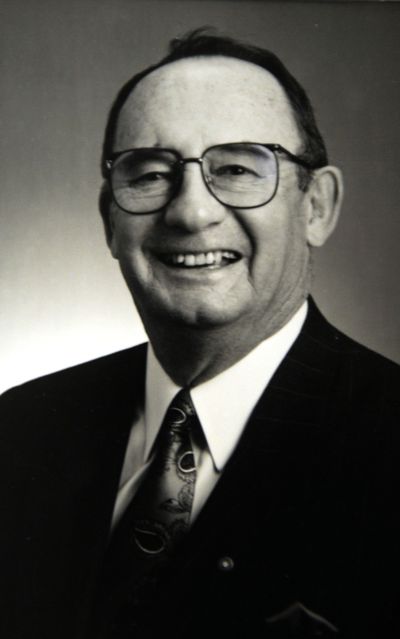Former mayor wears other hats
Ray Stone’s band plays New Year’s Eve

If you’re a dancer, perhaps you know Ray Stone. He’s the 86-year-old leader and drummer of the six-piece Ray Stone Swing Band, popular throughout the area and playing its next gig New Year’s Eve at the Coeur d’Alene Inn.
If you don’t know him, you might want to introduce yourself during a break in the music. You’ll find he’s a bit more than a musician: He was a city councilman for eight years, an educator and mayor of Coeur d’Alene from 1985 to 1994.
But there’s more to Stone’s story than that.
As a young paratrooper with the 82nd Airborne Division, he was one of the first liberators of Camp Wobbelin in Nazi Germany. He and his fellow troopers found 1,000 dead – mostly Jews – and another 3,000 dying prisoners in the compound, a way station for men, women and children on their way to the Auschwitz or Bergen-Belsen death factories.
In a staccato recitation, Stone recalls that terrible day: “On May 2, 1945, we were in downtown Ludwiglust directing traffic of the 21st German Army Group that was surrendering to the 82nd. That afternoon someone from regimental headquarters said to go out to a nearby camp.
“I was in the lead jeep as a machine gunner. We went down the road for a mile or two and turned left through the main gate. On the left-hand side of the road, just before going through the gate, we observed ragged individuals, also tattered clothing hanging on fences for about 200 yards.
“Going into the camp we looked for German soldiers. They had evidently departed within an hour before our arrival. There were inmates on the ground unable to stand or walk. The barracks were fairly large with tiered shelving probably five shelves high.
“On these shelves were the inmates, some alive, some dead and some dying. There were probably five or six large barracks in the camp. Someone called for the medics, and they arrived with some food and medical help.”
After two hours in the camp, Stone went back to directing traffic in Ludwiglust. A year later he was discharged and resumed his civilian life with his wife Betty, whom he had married in 1944.
With the help of the GI Bill, he went to college, earning a B.A. in history and education from Whitworth College in 1951 and a master’s in education from the same school the following year. He taught at Coeur d’Alene High School, then North Idaho College where he was eventually appointed dean.
But he couldn’t forget Camp Wobbelin, “The most fearsome, depressing, traumatic experience of my life.”But even if he wished to forget, a reminder came in the form of a man named Richard Butler, who moved to Hayden Lake in 1972 as leader of the neo-Nazi Aryan Nations.
Stone had been out of politics for about five years when he was elected mayor, and during that period a human relations task force had been formed in Coeur d’Alene to counter the white supremacists and their allies, including the Ku Klux Klan. Stone became active in the task force, even as Aryan Nation members bombed homes and businesses in the city.
Back east, a committee was formed in the name of Raoul Wallenberg, a Swedish diplomat who saved an estimated 100,000 Hungarian Jews during World War II by issuing them passports and hiding them.
The committee established an award in Wallenberg’s name, and in 1987 Coeur d’Alene received the first to be presented to a city. Two other community leaders in the struggle against prejudice, Bill Wassmuth and Kootenai County Undersheriff Larry Broadbent, accompanied Stone to receive the award and accept a gift of $5,000 on behalf of the city.
The money was used to refurbish a collection of human rights material in the city library.
A year later, council members of the new U.S. Holocaust Museum in Washington, D.C. summoned Stone to the nation’s capital to award him the Eisenhower Liberation Medal for his part in the liberation of the Wobbelin Camp and because of Coeur d’Alene’s stand for human rights. His fellow recipient was Gen. James Gavin who had commanded the 82nd Airborne Division during the war.
A prized memento in Stone’s papers is a letter from a New Yorker named Arthur Ruben. It reads, in part, “You and your fellow servicemen of the 82nd Airborne Division saved my life and that of my friends when you liberated Camp Wobbelin in Germany. Had the liberation taken place a week later, most likely I would not be writing this letter to you.
“By the time you liberated the camp I was so emaciated, skeletal and sick that I no longer had the strength of stand on my own. I literally had to crawl to a table or wall to pull myself up like a baby does.
“Unfortunately, when the war was over, I found out that my mother, five brothers and only sister were all killed. In addition, my 82-year-old grandfather, almost all my uncles, aunts and cousins were also killed in the concentration camps of Auschwitz. In my immediate family, only my father and myself survived the German massacre.”
Ruben noted that he’d immigrated to the U.S. after the war, served in the U.S. Army, married and had three children.
He concluded by writing, “I am happy to have the good fortune of having the chance to thank you and all the other servicemen of the 82nd Airborne, from the depths of my heart for all that I enumerated in this letter.”
And there’s another award on the wall of the Stones’ home. It’s a Bronze Star, awarded by the Army for his service in three campaigns, including the Battle of the Bulge.
“I’m not sure if it’s for any specific action,” he says. “It’s written kind of vague.”